Mahatma Gandhi Series
The Gandhi Series of banknotes are issued by the Reserve Bank of India (RBI) as the legal tender of Indian rupee. The series is so called because the obverse of the banknotes prominently display the portrait of Mahatma Gandhi. Since its introduction in 1996, this series replaced all Lion Capital Series banknotes issued before 1996. The Reserve Bank of India (RBI) introduced the series in 1996 with 10 and 500 rupee banknotes.
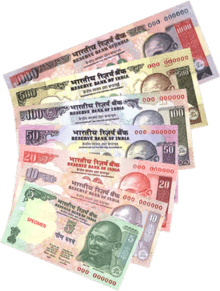
As of 10 November 2016, the RBI issues banknotes in this series in denominations from ₹5 to ₹100. Printing of five-notes, which had stopped earlier, restarted in 2009. On 8 November 2016, the ₹500 and ₹1000 banknote denominations of this series were demonetised and the new Mahatma Gandhi Series of banknotes were revealed in denominations of ₹500 and ₹2000, intended to replace this series.
Security features


The following features are included in the notes.[1]
- Security thread: The notes contain an embedded security thread that can be seen as a vertical straight line when held against a light source. The notes contains the words 'Bharat' in Devanagari and RBI. The ₹1000 denomination contains the number 1000 as well. Older notes, however, are not readable.
- Latent image: When held against the light at an angle of 45 degrees, an inscription of the value of the denomination is seen on the right side of Mahatma Gandhi's image.
- Microlettering: Micro-letters are used to print RBI on ₹10 notes, and the value of the denomination on other notes.
- Intaglio print:
- An intaglio (raised) shape is present on all denominations other than the ₹10 note to help the visually impaired.
- ₹20-Vertical rectangle
- ₹50-Square
- ₹100-Triangle
- ₹500-Circle
- ₹1,000-Diamond
- The image of Mahatma Gandhi, Reserve Bank of India seal, clause of guarantee, Ashoka Pillar emblem and signature of the governor of the Reserve Bank of India are all intaglio prints.
- Fluorescence: The number panels are printed with fluorescent ink.
- Optical fibre: The notes have optical fibres that glow when exposed to ultra-violet light.
- Optically variable ink: Denominations of ₹500 and ₹1000 are printed with ink that changes color with the angle of placement to light.
- See-through registration device – A floral design (later issues now have the corresponding denomination) printed on the front and the back of the note coincides and perfectly overlap each other when viewed against a light source.
- EURion constellation – A pattern of symbols found on the banknote helps software detect the presence of a banknote in a digital image so that it can prevent its reproduction with devices such as color photocopiers.
- Angular lines: A series of lines placed on both the left and right side of the ₹100, ₹500 and ₹1,000 notes. They are only featured on the 2015 series notes, and are utilised to help those with visual impairments in identifying the notes.
- Novel numbering: A set of six digit serial numbers that increase in size from left to right. Issued for the 2015 and 2016 series ₹20, ₹50, ₹100, ₹500 and ₹1,000 notes.
Banknotes
| Mahatma Gandhi Series[2] | ||||||||||
|---|---|---|---|---|---|---|---|---|---|---|
| Image | Value | Dimensions (millimetres) | Main colour | Description | Date of | |||||
| Obverse | Reverse | Obverse | Reverse | Watermark | Issue | Withdrawal | ||||
.jpg) |
.jpg) |
₹5 | 117 × 63 mm | Green | Mahatma Gandhi | Tractor | Mahatma Gandhi | 2002 / 2009 | Current | |
_2016.jpg) |
_2016.jpg) |
₹10 | 137 × 63 mm | Orange and violet | Rhinoceros, elephant, tiger | 1996 / 2006 | Current | |||
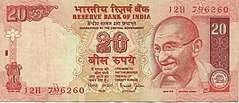 |
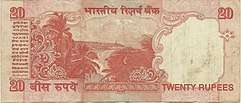 |
₹20 | 147 × 63 mm | Red-orange | Mount Harriet, Port Blair | 2001 / 2006 | Current | |||
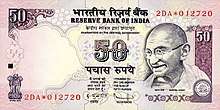 |
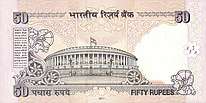 |
₹50 | 147 × 73 mm | Violet | Parliament of India | 1997 / 2005 | Current | |||
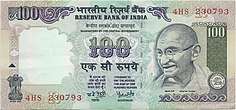 |
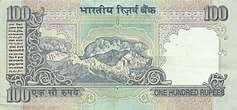 |
₹100 | 157 × 73 mm | Blue and green at centre, brown and purple at 2 sides | Himalaya Mountains | 1996 / 2005 | Current | |||
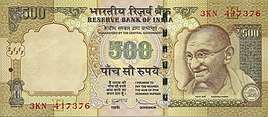 |
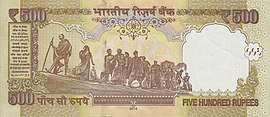 |
₹500 | 167 × 73 mm | Orange and Yellow | Dandi March | 2000 / 2005 | 8 November 2016 | |||
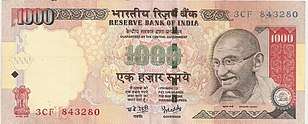 |
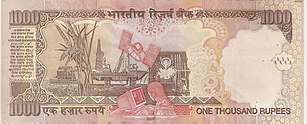 |
₹1000 | 177 × 73 mm | Amber-Red | Economy of India | 2000 / 2005 | 8 November 2016 | |||
| These images are to scale at 0.7 pixel per millimetre. For table standards, see the banknote specification table. | ||||||||||
Languages
Each banknote has its amount written in 17 languages. On the obverse, the denomination is written in English and Hindi. On the reverse is a language panel which displays the denomination of the note in 15 of the 22 official languages of India. The languages are displayed in alphabetical order. Languages included on the panel are Assamese, Bengali, Gujarati, Kannada, Kashmiri, Konkani, Malayalam, Marathi, Nepali, Odia, Punjabi, Sanskrit, Tamil, Telugu and Urdu.
| Denominations in central level official languages (At below either ends) | ||||||||
|---|---|---|---|---|---|---|---|---|
| Language | ₹5 | ₹10 | ₹20 | ₹50 | ₹100 | ₹500 | ₹1000 | |
| English | Five rupees | Ten rupees | Twenty rupees | Fifty rupees | One hundred rupees | Five hundred rupees | One thousand rupees | |
| Hindi | पाँच रुपये | दस रुपये | बीस रुपये | पचास रुपये | एक सौ रुपये | पांच सौ रुपये | एक हज़ार रुपये | |
| Denominations in 15 state level/other official languages (As seen on the language panel) | ||||||||
| Assamese | পাঁচ টকা | দহ টকা | বিছ টকা | পঞ্চাশ টকা | এশ টকা | পাঁচশ টকা | এহেজাৰ টকা | |
| Bengali | পাঁচ টাকা | দশ টাকা | কুড়ি টাকা | পঞ্চাশ টাকা | একশ টাকা | পাঁচশ টাকা | এক হাজার টাকা | |
| Gujarati | પાંચ રૂપિયા | દસ રૂપિયા | વીસ રૂપિયા | પચાસ રૂપિયા | સો રૂપિયા | પાંચ સો રૂપિયા | એક હજાર રૂપિયા | |
| Kannada | ಐದು ರುಪಾಯಿಗಳು | ಹತ್ತು ರುಪಾಯಿಗಳು | ಇಪ್ಪತ್ತು ರುಪಾಯಿಗಳು | ಐವತ್ತು ರುಪಾಯಿಗಳು | ನೂರು ರುಪಾಯಿಗಳು | ಐನೂರು ರುಪಾಯಿಗಳು | ಒಂದು ಸಾವಿರ ರುಪಾಯಿಗಳು | |
| Kashmiri | پاژشھ رۄپے | دہ رۄپے | وھ رۄپے | پاژاھ رۄپے | ھطم رۄپے | پاژشھ ھطم رۄپے | ساس رۄپے | |
| Konkani | पांच रुपया | धा रुपया | वीस रुपया | पन्नास रुपया | शंबर रुपया | पाचशें रुपया | एक हजार रुपया | |
| Malayalam | അഞ്ചു രൂപ | പത്തു രൂപ | ഇരുപതു രൂപ | അൻപതു രൂപ | നൂറു രൂപ | അഞ്ഞൂറു രൂപ | ആയിരം രൂപ | |
| Marathi | पाच रुपये | दहा रुपये | वीस रुपये | पन्नास रुपये | शंभर रुपये | पाचशे रुपये | एक हजार रुपये | |
| Nepali | पाँच रुपियाँ | दस रुपियाँ | बीस रुपियाँ | पचास रुपियाँ | एक सय रुपियाँ | पाँच सय रुपियाँ | एक हजार रुपियाँ | |
| Odia | ପାଞ୍ଚ ଟଙ୍କା | ଦଶ ଟଙ୍କା | କୋଡିଏ ଟଙ୍କା | ପଚାଶ ଟଙ୍କା | ଏକ ଶତ ଟଙ୍କା | ପାଞ୍ଚ ଶତ ଟଙ୍କା | ଏକ ହଜାର ଟଙ୍କା | |
| Punjabi | ਪੰਜ ਰੁਪਏ | ਦਸ ਰੁਪਏ | ਵੀਹ ਰੁਪਏ | ਪੰਜਾਹ ਰੁਪਏ | ਇਕ ਸੌ ਰੁਪਏ | ਪੰਜ ਸੌ ਰੁਪਏ | ਇਕ ਹਜ਼ਾਰ ਰੁਪਏ | |
| Sanskrit | पञ्चरूप्यकाणि | दशरूप्यकाणि | विंशती रूप्यकाणि | पञ्चाशत् रूप्यकाणि | शतं रूप्यकाणि | पञ्चशतं रूप्यकाणि | सहस्रं रूप्यकाणि | |
| Tamil | ஐந்து ரூபாய் | பத்து ரூபாய் | இருபது ரூபாய் | ஐம்பது ரூபாய் | நூறு ரூபாய் | ஐந்நூறு ரூபாய் | ஆயிரம் ரூபாய் | |
| Telugu | ఐదు రూపాయలు | పది రూపాయలు | ఇరవై రూపాయలు | యాభై రూపాయలు | నూరు రూపాయలు | ఐదువందల రూపాయలు | వెయ్యి రూపాయలు | |
| Urdu | پانچ روپے | دس روپے | بیس روپے | پچاس روپے | ایک سو روپے | پانچ سو روپے | ایک ہزار روپے | |
References
- Reserve Bank of India Currency Frequently Asked Questions (FAQ) Archived 2011-01-16 at the Wayback Machine 9 January 2012
- "Reserve Bank of India — Bank Notes". Rbi.org.in. Archived from the original on 26 October 2011. Retrieved 5 November 2011.